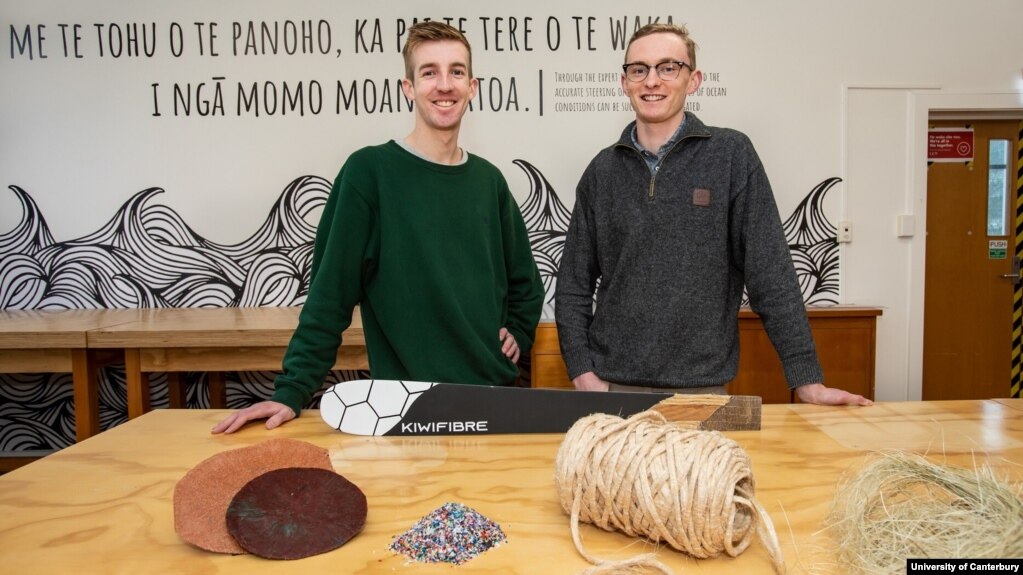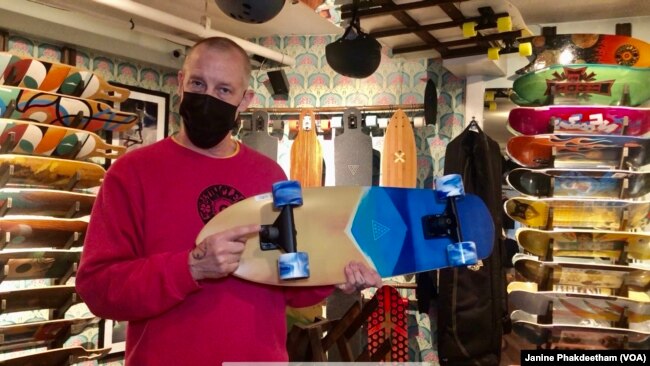
Ben Scales (left) and William Murrell (right) are two students at New Zealand’s University of Canterbury. They believe they can make skateboards and other sporting equipement even stronger by using fiber from plants. (University of Canterbury, FILE)
Students from New Zealand have developed sustainable materials made from the leaves of a tree local to New Zealand, the cabbage tree, and a plant whose seeds are often eaten, flax.
Sustainable materials are products that are made that limit their harm to the environment and the amount of resources they take. They support a long-term ecological balance.
The sustainable material the New Zealand students developed could soon be used to make high-performance outdoor sporting equipment like skis, kayaks, and skateboards. Their plan is to replace the traditional materials that are used like fiberglass and carbon fiber.
Skateboards need to be strong. Ben Scales and William Murrell are two students at New Zealand’s University of Canterbury. They believe they can make them even stronger by using fiber from plants.

Co-owner of Uncle Funkys Boards, Jeff Gaites, holds a Surfskate, a skateboard, inside his shop in Manhattan, New York March 25, 2021.
After experimenting in their at-home workshops, they created new, natural composite material, or material made up of different items.
Scales is 21 and studies product design. He said their first attempt is looking good.
Scales said their first experimental product is a skateboard. It is made up of 25 percent fiber from a plant called harakeke and 75 percent recycled polylactic acid, which is plastic made from corn starch.
He said the material is good to make a skateboard because it can take the force and shocks skateboards receive better than what skateboards are now made from: wood or carbon-fiber.
The fiber is taken from the Harakeke plant, which is a native flax plant in New Zealand. The fiber is mixed with different resins, which is a product that comes from some trees that can be used to cover a surface or hold objects together. Leaves from the cabbage tree are also an important part in their material.
The plan is to use these sustainable materials to make skis, snowboards, and kayaks. These outdoor sporting items are currently made from nonnatural materials like fiberglass and carbon fiber.
The university students have found interest from possible business partners in other countries.
Scales said some of the companies include businesses in Europe that make boats to skis and a few overseas startups that are looking to shape the personal transport industry.
He said, “… they are looking to use sustainable materials that just are not offered in industries like that. So, they are wanting to use our material once we have gotten it ready, which will hopefully be soon.”
If they are successful, the students could bring new life to New Zealand’s flax fiber industry. They could also bring back practices used by the native people, the Māori, before European colonization.
Words in This Story
sustainable – adj. something that can be maintained, and ecologically, a way of working or making something that does not hurt the environment
fiber –n. a thin thread of natural or artificial material that can be used to make cloth, paper, or other materials
recycle –v. to make something new from (something that has been used before)
starch –n. a substance that is found in certain foods (such as bread, rice, and potatoes)
startup –n. a new business
Comprehension Quiz
1. What is the story mainly about?
2. What does Scales study?
3. What was their first experimental product?
4. Where is the fiber taken from?
5. What is the fiber mixed with?